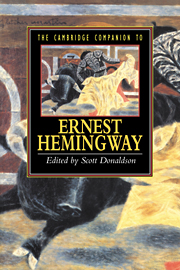Book contents
- Frontmatter
- 1 Introduction
- 2 Hemingway's journalism and the realist dilemma
- 3 1924
- 4 In Our Time, out of season
- 5 Brett and the other women in The Sun Also Rises
- 6 A Farewell to Arms
- 7 Hemingway's late fiction
- 8 Hemingway and politics
- 9 Hemingway and gender history
- 10 Hemingway, Hadley, and Paris
- 11 Hemingway's Spanish sensibility
- 12 The Cuban context of The Old Man and the Sea
- 13 Conclusion
- Selected Bibliography
- Index
- Series List
2 - Hemingway's journalism and the realist dilemma
Published online by Cambridge University Press: 28 May 2006
- Frontmatter
- 1 Introduction
- 2 Hemingway's journalism and the realist dilemma
- 3 1924
- 4 In Our Time, out of season
- 5 Brett and the other women in The Sun Also Rises
- 6 A Farewell to Arms
- 7 Hemingway's late fiction
- 8 Hemingway and politics
- 9 Hemingway and gender history
- 10 Hemingway, Hadley, and Paris
- 11 Hemingway's Spanish sensibility
- 12 The Cuban context of The Old Man and the Sea
- 13 Conclusion
- Selected Bibliography
- Index
- Series List
Summary
In November 1923, after having written for his high school newspaper, trained as a cub reporter for the Kansas City Star, and worked as a correspondent for the Toronto Star on and off from 1920, Hemingway wrote to Gertrude Stein, “I am going to chuck journalism I think. You ruined me as a journalist last winter” (SL 101). Yet Hemingway stayed with the Toronto Star until September 1924, and he continued to write for newspapers and magazines at intervals throughout his career, covering the Spanish civil war for the North American Newspaper Alliance in 1937 and 1938, the tension in the Orient for PM in 1941, and World War II in England and France for Collier's in 1944, as well as writing intermittently for Esquire, Look, and Life, among other publications, until as late as 1960, all the while producing short stories, novels, and other books and essays of creative nonfiction as well.
Although Hemingway often complained that journalism robbed him of the juices he needed to write fiction, there is evidence that moving among journalism, creative nonfiction, and fiction stimulated all his writing, that his work in each genre informed and enriched his experience in the others. In this essay I will examine the journalism Hemingway produced at intervals throughout his life, focusing on the significance of the choices this writer of realist fiction made when he found himself reporting real life and on how these choices in turn inform his fiction. I demonstrate that throughout his career Hemingway tends to blur distinctions between fiction and nonfiction as well as between the concrete and imagined realities they purport to represent.
- Type
- Chapter
- Information
- The Cambridge Companion to Hemingway , pp. 16 - 35Publisher: Cambridge University PressPrint publication year: 1996
- 2
- Cited by



